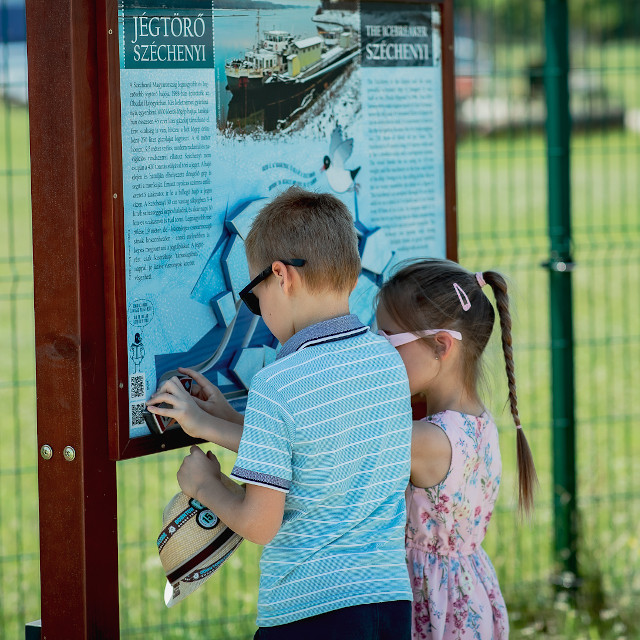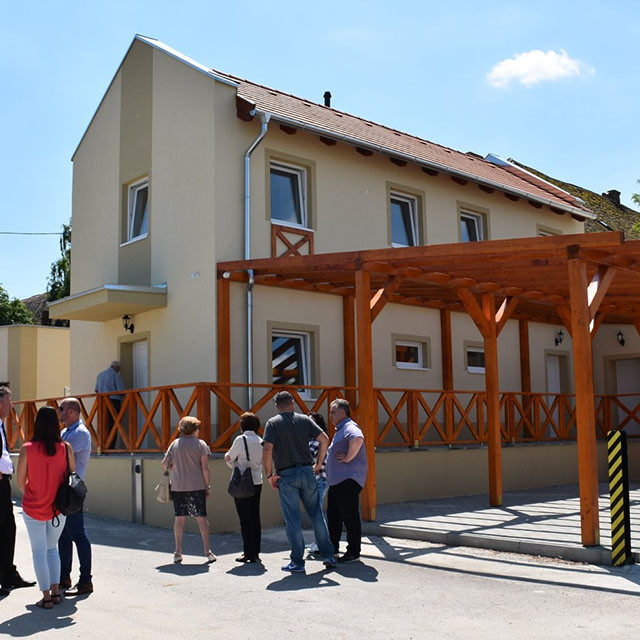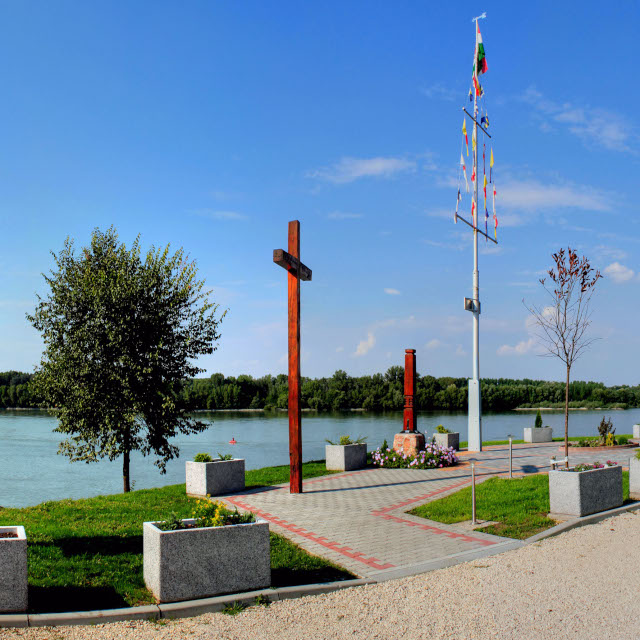Danube Panorama Nature Trail
Just like the travellers in the old days, today’s tourists can have a rest on the Danube bank offering full of delights and natural beauty for the eye, whether they arrive by bike on the EuroVelo 6 route, or by car on Highway 1 or from the direction of the watercourse. The welcome point of the trail is at the corner of the old highway covered with cobblestones, Kossuth Lajos Street and Rákóczi Ferenc Street, at the cross. This is from where the bird trail leads to the Danube offering you an unexpected view. Visitors are led by Hungarian and English written, interactive boards. The walk offers experience for every generations. Some will enjoy the panorama, others read the interesting stories about Gönyű’s history, and surely lot’s of people will download the films and the application or even the tale with their smart phones. From the view point you can observe the bird’s life, and also a boatmen playground awaits children.
We offer a booklet for 6-10 years old children, with entertaining tasks. The booklet is to download from here.
 |
 |
 |
Life on the Danube bank - exhibition of local history
The exhibition presents the treasures of the local shipping dynasties, just like uniforms, ship models or awards and also fishing relics. There is also an interactive rostra with a soundable ship bell, and it gives perfect possibility for taking some selfies. The motto has not changed since the Roman age: „Navigare necesse est!”, that is: “To sail is necessary!” - Pompeius Magnus
The exhibition is visitable every day, you should just call one of these numbers: 0036306954043, 0036204811694, 0036306768651
 |
 |
 |
Fishing Cottage Visitor Center and Garden-Restaurant Erebe
The Visitor Center will offer touristic information about the local and regional attractions and services. The gourmets can choose fish or street food from the seasonal refreshed menu card in the garden restaurant just beside the Danube. The bar will provide eiscream, assorted wine, refreshers, lemonade and coctail. The Visitor Center and also the restaurant will be opened in May 2020.
 |
 |
 |
Saint Peter and Paul Roman Catholic church
The Catholic church protected as a national monument was built on behalf of the noble Eszterházy family. It was consecrated in honour of Saint Peter and Paul in 1795. The building is characterised by the marks of the Louis Seize, also known as late baroque style. The carved family coat of arms with a griffin raising a sword is placed above the main entry, and the board commemorating the renovation in Latin is placed also here. The church can be visited only during the masses. The mass schedule is displayed on the advertising board in front of the church.
 |
 |
Reformed-Evangelist church
The church was consecrated during the Whit holidays in 2005. The building is characterised by the traditions of centuries of Protestant church construction and the modern architectural expectations. Its style reminds the nice atmosphere of the small churches of the Transylvanian villages. The opening hours of the church are displayed on the advertising board in front of the church.
 |
 |
Catholic relics
Chapel
The crypt of the Eszterházy family was built in the cemetery still in use in 1863. Currently, it serves as a chapel for funerals.
 |
Crosses
The locals are protected by two crosses on the old main street of the village, on Kossuth Lajos Street and at the corner of Rákóczi Ferenc and Kikötő Streets.
 |
 |
 |
Local history relics
Cobbled street
The Lajos Kossuth street is the longest cobblestone road considering Hungarian villages. It is almost 3 km long. At the time of the Roman Empire an important road run here, through Gönyű, which connected Arrabona (nowadays Győr) and Brigetio (nowadays Szőny). This street represents the basis of the cobblestone road, which was earlier the main road between Budapest and Vienna.
The stones were made of volcanic stone, mainly basalt. It could be laid down different way. Here was chosen the wave pattern. This was a smart method, because the stones have different size and form, and this way almost every stone could be used. The basalt fitting was popular until the II. World War. After 1960 mostly asphalt was laid down. The advantage of cobblestone is that it is of high consistency and it can be used more times, since the stones are not connected to each other. Its disadvantage is that it is slippery when it is wet.
 |
 |
Ship mast
The ship mast erected on Háry Dezső square and inaugurated by the Local History Club is unique in Hungary. New flags are attached to the mast before the celebration of 15 March, which is a memorial day of the revolution and fight for freedom of 1848-1849 each year. The aim is to proudly show boatmen travelling on the Danube that a “shipping village” is located here. Code flags are placed on the mast, each indicating a letter, but they are used by the Hungarian boatmen rather as ceremonial county flags.
 |
 |
Memorial to World Wars 1 and 2
The memorial of the victims of Gönyű serving on the battlefield is located in front of the Roman Catholic church.
Memorial to the Steamboat Árpád
A tragic event took place in Gönyű, during World War 2, on 28 July 1944. The Árpád steamboat ran on a mine and exploded at Vének, and took three boatmen of Gönyű with itself into the watery grave. The rope reel of the boat taken out in 2003 is shown at the local history exhibition and the boat crane is located in the cemetery as a memory of the tragedy.
 |
Holocaust Memorial
In 1944, members of the Arrow Cross Party crowded the Jews on four anchored barges at Gönyű. Many died there, right on board or by falling into the Danube. A monument in the form of a sinking boat has been erected in the cemetery as a memory of them and other victims of World War 2.
 |





